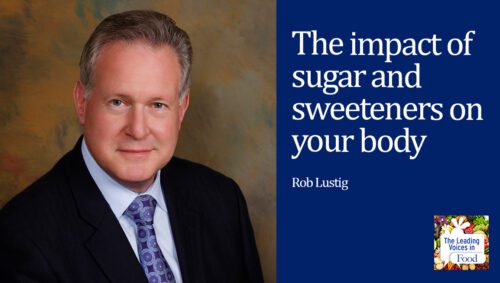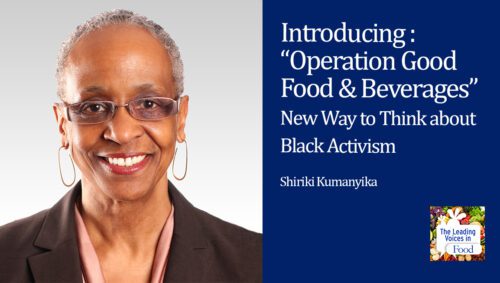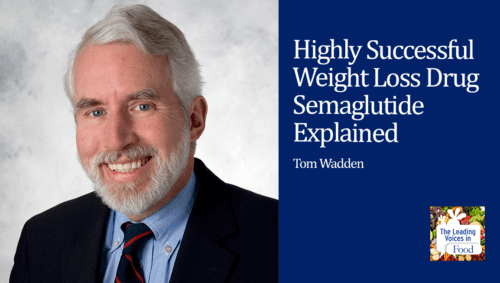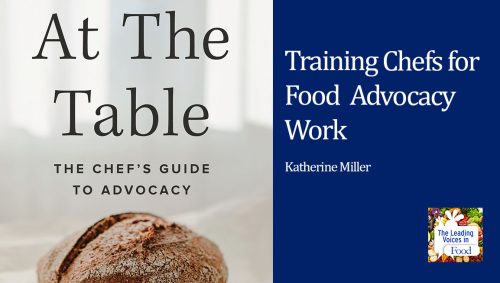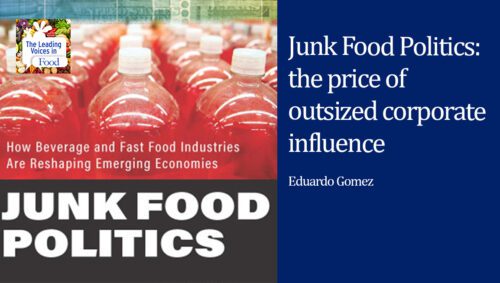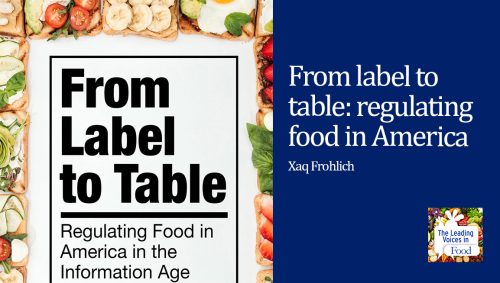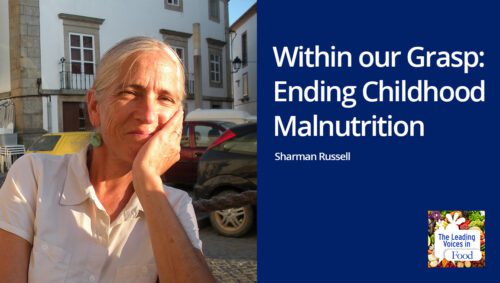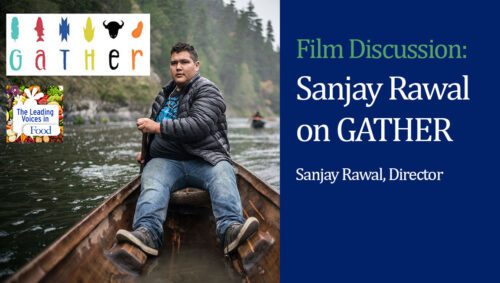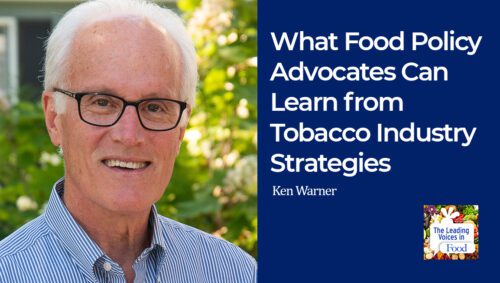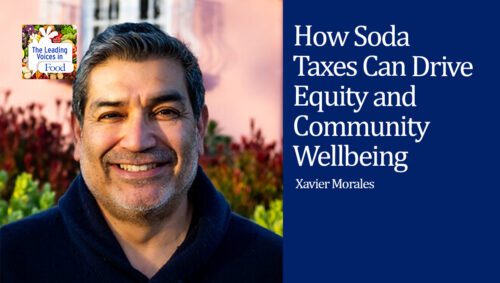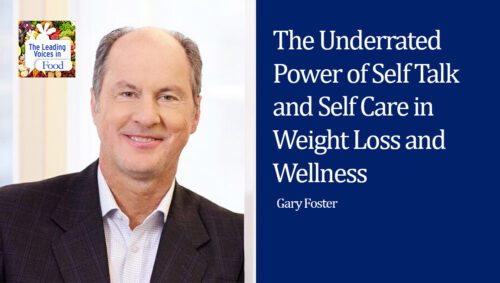The Leading Voices in Food
E161: New Movie “El Susto” Tackles the Tragedy of Sugary Drinks in Mexico
Consumption rates of sugared beverages in Mexico are extraordinary and take a very real toll on the health and well-being of the people who live there. Today’s guest tells that story in a film called “El Susto.” In response to the health crisis precipitated by soda consumption, the Mexican government passed a soda tax in 2014. While Mexico is one of more than 50 countries with such taxes, it is a place where the story has been told in the most detail, in a combination of scientific studies, press coverage, and now the film “El Susto.” This award winning film was created by documentary filmmaker, Karen Akins, who joins us today.
Subscribe: Apple Podcasts | TuneIN | Google Podcasts | SoundCloud | PocketCasts | Radio Public
Tags: Addiction & Food | Advocacy & Food | Food Policy | International Food & Ag Policy | Movies & Food | Soda Taxes | Weight Stigma |
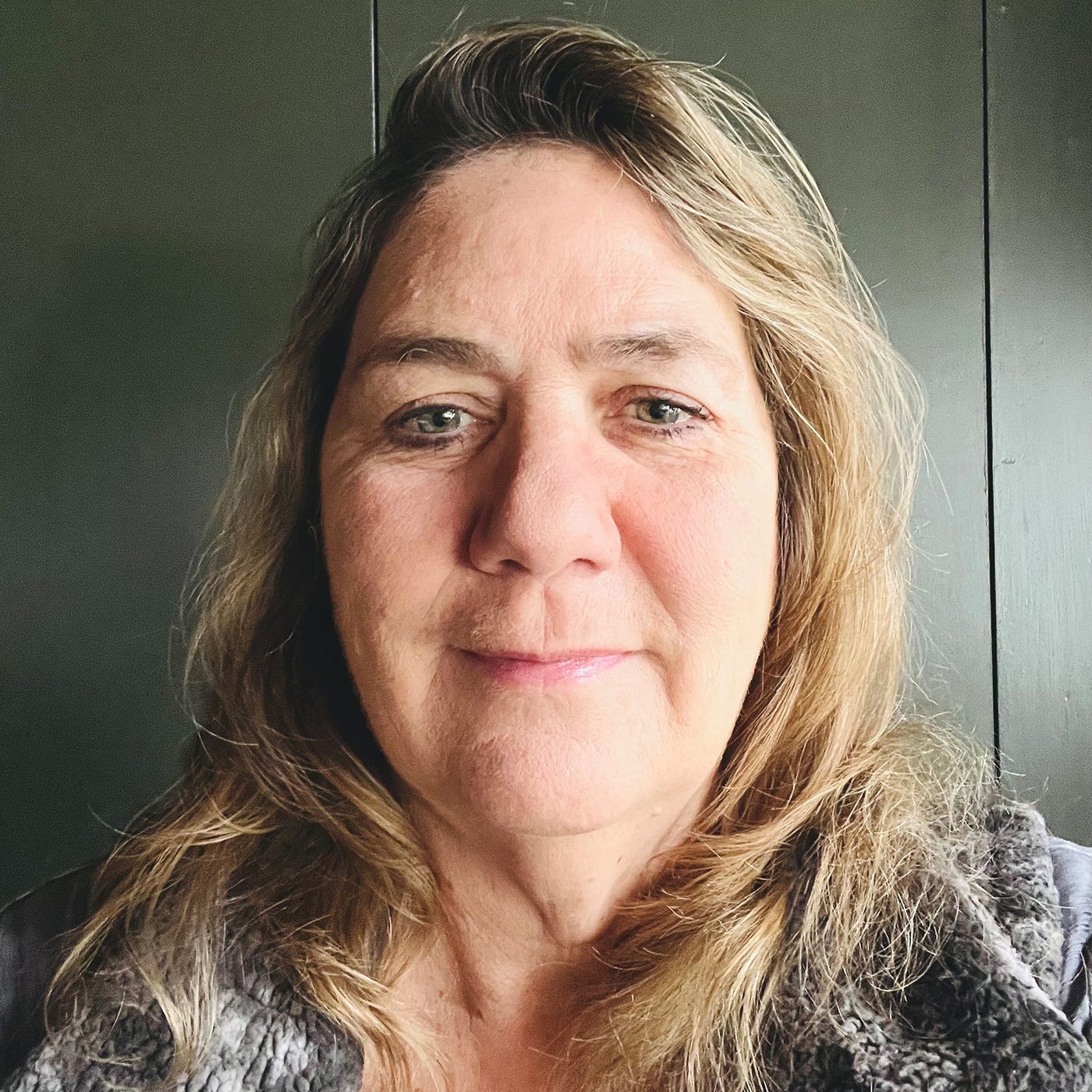
Karen Akins is a former activist on safe and active transportation and emerging filmmaker who has just completed EL SUSTO, her first documentary film, about the politics of sugary drinks and diabetes in Mexico. A trained urban designer, MSc. in City Design and Social Science from the London School of Economics, she became aware of the diabetes epidemic on a volunteer medical mission to Mexico.
Interview Summary
Well, let me begin by saying that I found the film powerful, beautiful, disturbing, and most of all, insightful. And I’ve been involved with this issue for decades and see your film as a really essential part of understanding this issue. Something that goes far beyond the usual studies, reports, and expert testimony that we’re accustomed to seeing. The film really brings this issue alive in important ways. But why don’t we begin with a fundamental question: How did you get interested in the issue?
Well, I have no background in medicine or nutrition, but I had signed up for a volunteer medical mission to Mexico back in 2008. Right at the point where my kids had left home and I found myself an empty nester with a little flexibility to do something like that for a month. I knew very little about diabetes at the time. But I found myself with a small group of nurses from Vermont, going around to villages and towns in Mexico, testing various people’s blood sugar. And it was truly eye-opening and, as you say, disturbing. Many of the people had no idea they had diabetes. They knew nothing about the disease at all or how it was related to nutrition. So that was my introduction to the topic.
Well, a very profound, personal experience it sounds like. So how does “El Susto” translate into English? And would you explain how it came to symbolize the themes in your film?
It’s funny because the original title of the film was “Enjoy Diabetes,” but something happened along the way, and we changed the name to “El Susto.” So the word el susto literally is translated as a shock or a fright. A very high percentage of people in Mexico and Central America believe that diabetes is caused by having a shock, not anything that they eat or drink. It’s referred to as a folk illness, and it’s often treated by a shaman. So on a personal basis, there’s this belief that a life event has caused a person’s diabetes. But I kept hearing this from people we were testing. We would say, “oh, you know, your blood sugar is 350,” and they said, “oh, I must have the susto,” and we were like, the what? So when I was interviewing Dr. Pilar Zazueta, professor of Latin American Studies in Austin, I kind of had a throwaway question at the end of our interview about susto. But she ended up answering it so eloquently that we ended up changing the title of the film. What she said was that susto was their way of making sense of how their lives were being disrupted. So that concept of susto applies to a person’s health, but it can also be applied to a culture that has seen an intrusion from an outside force such as processed foods from the US. And also, what the soda companies did to the activists was shocking, so it’s a kind of another meaning there too to see how those for profit soda companies worked with their corrupt allies in government to try to undermine the public health.
So we’ll come back in a moment and talk about the companies and their activities. But before we do that, I thought a brilliant part of your film – a heartbreaking part to be sure – is how you conveyed the human suffering that you link with consumption of these beverages. Can you tell us a little more?
Well, you know, diabetes is a silent killer, so it’s really hard for people to see the human suffering unless maybe it’s within your family. And then you see somebody with their health declining, or they lost their job because they had an amputation and they can’t do it. And, you know, filmmaking is all about showing, not telling, so we had to show, in this case, both the heartbreak by interviewing people at the grave sides about their loved ones who have passed and also to show the extreme conditions associated with untreated diabetes, like amputations and blindness.
So tell us about children.
Well, you know, you hear stories of children in Mexico who are fed Coca-Cola in their baby bottles and have bottle mouth. But I can tell you the first time I saw a young girl who wouldn’t smile because her teeth were all rotted out, it really got to me. It it’s a huge dilemma for parents. They have water quality that’s not so great. So many times they’re forced to choose between bottled soda and the local water supply. You know, and getting cholera would be an immediate health crisis, whereas drinking soda – the effects may not show up for many years. So that’s sort of what they choose in the moment. The problem is that Coke is so prevalent in the culture that it’s normalized. It’s just a part of everyday life at this point. So at every meal, every celebration, and there’s signage everywhere you look. It’s even in the school sometimes, though it’s not supposed to be. So soda companies have kind of normalized the presence of their branding in the children’s life, and then the kids just drink it for the rest of their life.
You’re speaking to the massive reach and influence of the corporations. And we often hear people who travel to remote areas of countries around the world that companies like Coca-Cola in particular, but others as well, have enormous visibility. Even in the poorest places, you might find a cooler where the Coca-Cola logo is on it or other things. It’s a sounds like you saw a lot of that.
Yes. One of the stated marketing goals of Coca-Cola was “everywhere and all the time,” or another phrase was “within an arms’ reach of desire.” So it is just ever present. And that’s what makes it so very hard, especially once you’ve sort of become addicted to the sugar, to resist it because it’s just in your face all the time. And in Mexico, you definitely see that.
Well, let’s talk about the marketing that you observe. So certainly people consume these beverages because the sugar in them makes them taste good, and it is activating all sorts of things in the body, including the brain. But you’re talking about a marketing part of this as well, and Coca-Cola being associated with positive things. Do you see a lot of that?
Yes, for example, I think the sponsorship of athletic events, it is called health washing or something like that, where you take an unhealthy product, and then you sponsor sports teams. And then that association with your favorite team is what stays with you. And so they are very clever. I mean, I think the Coca-Cola company in particular invented the concept of marketing, and it’s no wonder they’re good at it. They put signage everywhere. They make sure that the portions are economical for the people. You see these huge zeplins, they call them – these two liter bottles that construction workers just grab and take for their lunch or just to sustain them throughout the day. And then that and the signage and the advertising everywhere definitely has its impact.
Let’s go back to the issue of shock that you brought up. You mentioned that some people believe this disease was brought on by some shock going on in their world. But you characterize one version of shock as what the companies have done in the country of Mexico and elsewhere, of course. So are the people of the country seeing corporate behavior as part of the shock that they’re experiencing?
I don’t think people have that perspective. I think that’s my perspective. I lived in Mexico in the late seventies, and I don’t remember that level of marketing. I think this all happened later in the eighties and the nineties, and that’s when you saw the big spike of diabetes. Unless you’re somebody that’s 60 or older, you may not even have seen the transformation. For everybody else, that’s just their normal. That’s what I think.
And did you see any difference between urban people and living in urban and rural areas about how they conceptualized why they were getting this disease?
Well, obviously people who are educated may have more of a sense that it’s a nutritional disease when they have diabetes. In the rural areas, they probably don’t. There is a difference there, but then again, even in Mexico City, the water system is so problematic that your friend and mine, Simon Barquera, the head of the Institute for Public Nutrition, said they put a water fountain out in their own area outside the building for people to use, and people wouldn’t drink it because they’re just so unsure about whether the water’s okay to drink. So that’s the middle of Mexico City. The water system is just so problematic, and cholera is a real thing. I think that is always in the back of people’s mind, the questioning the water quality, so they maybe justify drinking Coke based on that. And also, and probably in both areas, it is price. You have Coke that’s cheaper than water. So if you’re going to spend the money, why wouldn’t you get something that would give you some calories to get you through the day versus just hydration? So in that sense, there’s not that much difference.
You mentioned Dr. Barquera, and there are so many heroes in the Mexican effort to address this issue. Dr. Juan Rivera would be another, and then there are advocacy individuals and people in government. There are a whole lot of people that were responsible for getting the soda tax passed, and we’ve done a number of podcasts on soda taxes, but we’ve typically talked to government officials, advocates, or scientists but never a filmmaker. So what do you think the important perspective is that a filmmaker might bring to this?
Human beings incorporate information and change their behavior mostly based on emotion, so I think filmmakers can take a public health story and tell it in such a way that it will have much more of an emotional effect than like an academic paper or some kind of a fact sheet. I also think that a film that’s sort of geared for the general public is a way to synthesize academic research and put it into very human terms. And my father was a scientist, so I love science, but somebody needs to clearly explain it to me and to other laymen to understand.
From your perspective as a filmmaker, what sort of political process played out in Mexico regarding soda taxes?
The key players were the front groups for the soda companies and then the grassroots coalition in Mexico that was very widespread. It wasn’t just health nonprofits and that kind of thing. It was a wide range of members. So those were the two major political groups, but the politicians made the tax happen mostly out of economic necessity, not necessarily principle, in my opinion. They were looking for a revenue source since the medical system was on the verge of collapse, and it was the conservative party that proposed a tax, and the tax proponents had a window of opportunity, and things came together for them after trying for many years to get a soda tax.
The industry has spent unbelievable amounts of money fighting these soda taxes around the world, and at least at one point, Coca-Cola in Europe declared this was their number one public policy priority was to fight soda taxes. So what sort of tactics did you see them using in the Mexican content?
I think they tried to create doubt. They tried to act like it’s going to damage the local economy. They have kind of a playlist that’s very similar to the tobacco playbook that the tobacco companies used for many years to fight back against any kind of regulation and taxing on them. So it was a not very surprising way that they dealt with it, but it was very effective. And like I said, if it weren’t for the dire economic necessity, it probably wouldn’t have passed in Mexico, and, you know, it’s a hard sell in the United States, as you know, when the soda companies come in and say it’s going to hurt people or increase the grocery bills for families. So it’s tough, and they do that all over the world. They have it down.
You know, they do, and it is remarkable, as has been said a lot, how similar the soda industry script is to the tobacco industry script. You know, I was in Mexico some years ago in the early stages of the tax starting to take form, and I spoke with government leaders, with scientists there, and with people from advocacy groups. And some of the things that you were talking about the soda industry did were clear then, and some of the things he been much more disturbing than those that affected the personal lives very much of the people who were involved in this shows how powerful a tax can possibly be given how hard the industry is fighting against it. So let’s turn our attention a little bit to the human side of this, and this is something that your film truly brings alive and keep centered. And you mentioned how important that is in telling the story. Is there a particular story you might want to share with us that was very powerful to you?
Well, besides the little girl who I saw in a remote Mayan village who wouldn’t smile because her teeth were all rotted out, I would say that it was just these beautiful people living a very traditional way of life in remote areas of Mexico who were being affected health wise by the presence of the Coca-Cola Company. Many of these people rarely saw a doctor, and when we would come in to test their blood sugar, to see the looks on their face when we had to tell them that they were at risk for diabetes and pull them aside and try to give them some very basic information about the disease, I mean, it was life changing for them. And so those individual moments of having to tell somebody that they had a chronic disease or at least they were at risk for it since you really needed to be tested a couple of times, but to see the look on their faces, and, you know they had no idea that what they had been doing was wrong or would affect them later in life. That was just really sad, and it happened many, many times.
You know, now that you’ve been so close to this issue, do you have any suggestions that you think would be helpful for say people in government and the advocacy community to consider as they’re trying to deal with these issues in the future? You know, in a country akin to Mexico let’s say, where levels of obesity and diabetes are high, and there’s a terrible personal and health toll, and they’re starting to consider what might be done, what kind of things would you suggest?
Well, you know, I like the approach the folks in Berkeley are taking. You know, they’re very much linking the tax revenues to activities that mitigate the effects of soda consumption. They’re doing community gardens, cooking classes, and things like that. And if you don’t take the tax revenues and use them to build playgrounds or just things for health, it just looks like a sin tax. So I think that the more people can follow the approach of one of the places in the US with the longest running soda tax, I think they’ve really got it down there. They’re doing a good job. I would just say that would be the approach, just really just to link it to good projects.
Well, let me end with one of the most important questions of all. How can people see “El Susto”?
On April 5th, our film will start to hit digital platforms such as iTunes, YouTube, Xbox, Google. It’ll be on pay per view, on cable, and I think Amazon as well. So that’s the first phase, and then in July, it be available for free on a number of ad supported digital platforms. And community groups, we always have the film available to license for community screenings and for professors and people in the public school system. We do have educational licenses available for teachers who want to use it in their classrooms, and I get such nice letters from both students and teachers about how it’s really opened people’s eyes when they watch the film, and I would say from ages 12 up it’s appropriate.

